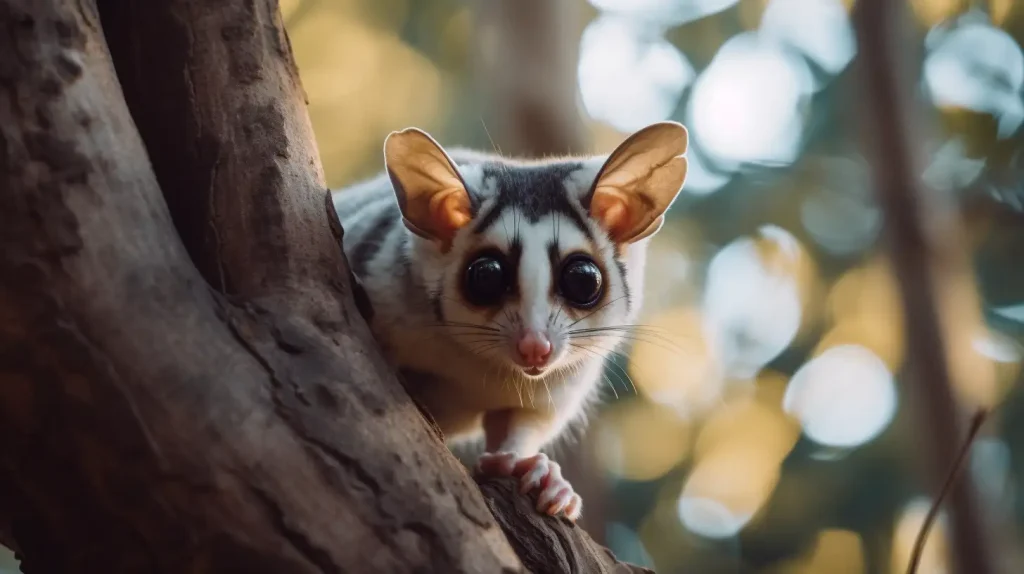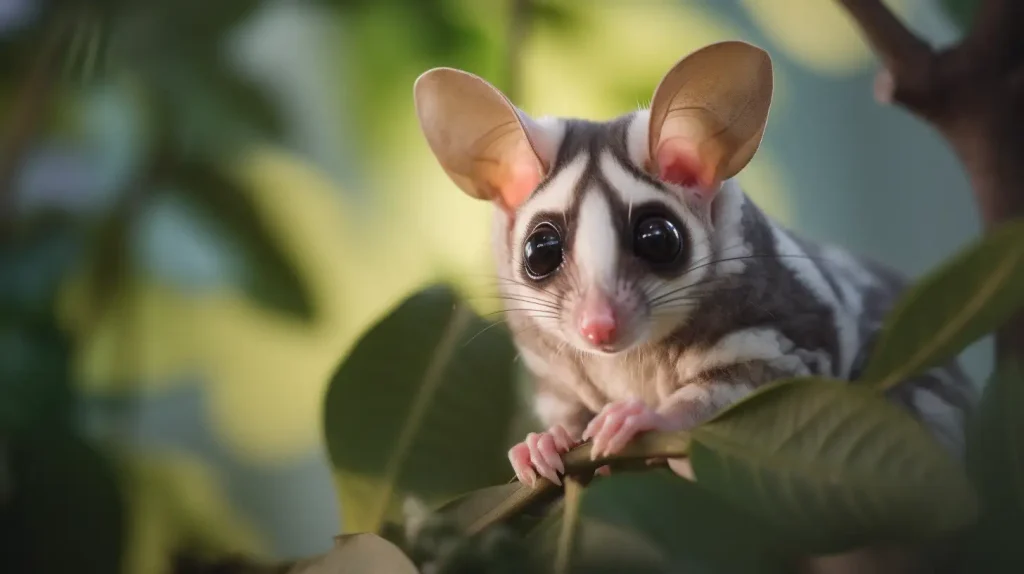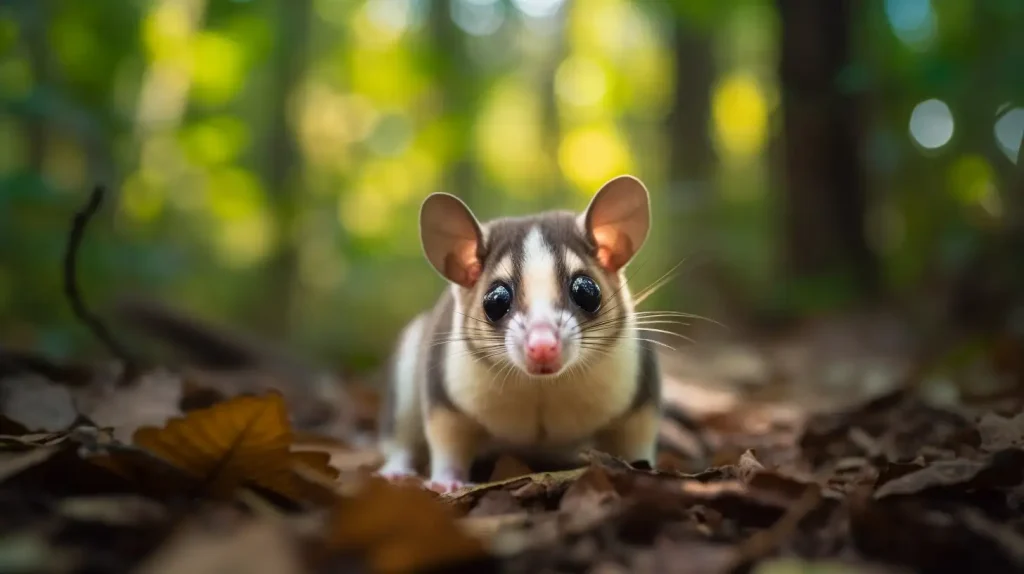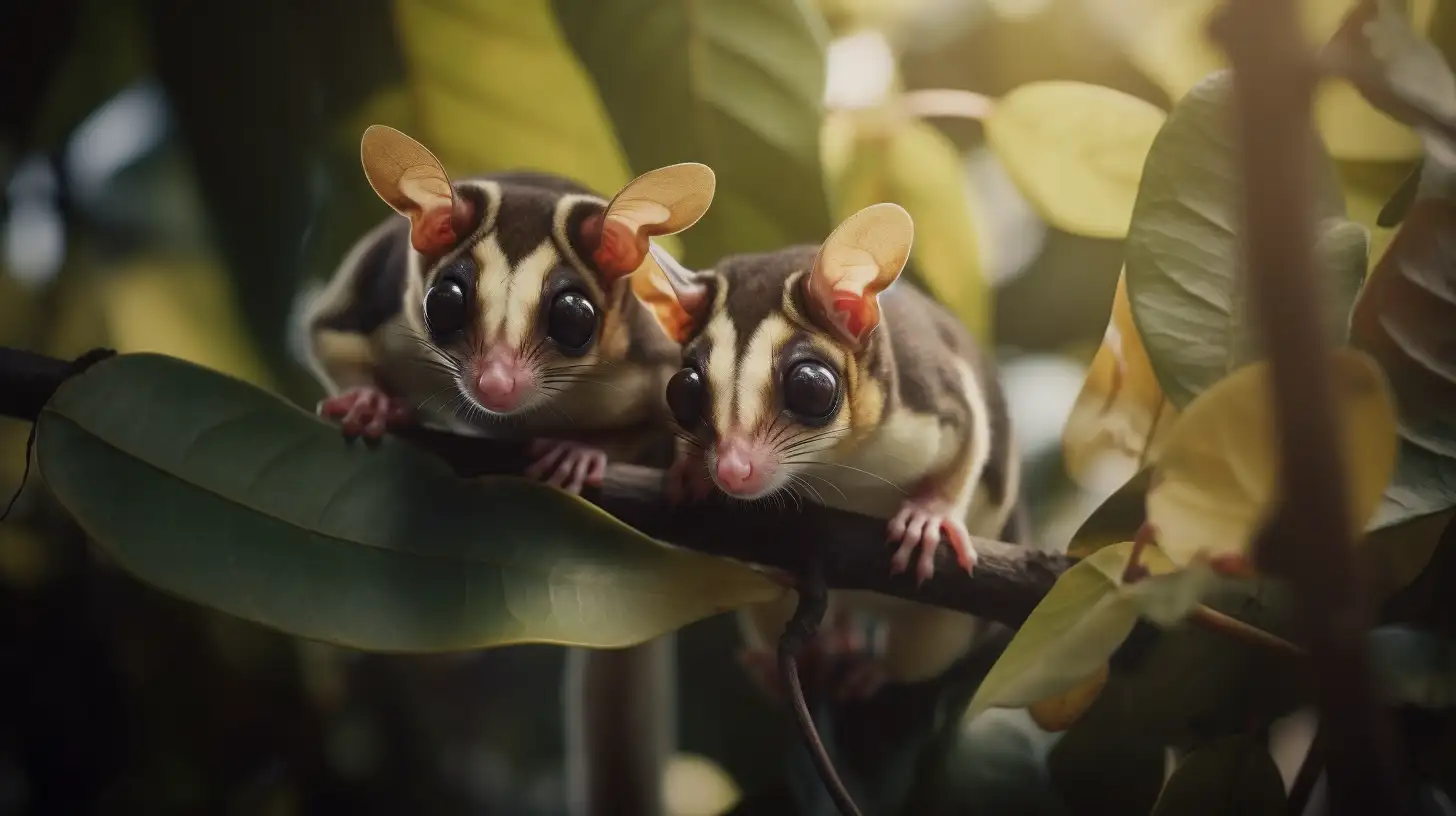Table of Contents
Most people associate the sound of barking with dogs, but sugar gliders also make a barking sound. And as with dogs, sugar gliders bark to communicate. They may be trying to communicate with other sugar gliders or with you. It could be due to excitement, wanting something, or simply from pure excitement.
In the wild, sugar gliders typically bark to warn others in the colony of a present danger. When a sugar glider barks in warning, others in the colony will usually freeze to avoid being seen by the predator.
typically bark to warn others in the colony of a present danger. When a sugar glider barks in warning, others in the colony will usually freeze to avoid being seen by the predator.
Sugar Glider Behavior and Body Language
Understanding the non-verbal cues of sugar gliders is equally as crucial as decoding their vocal communication. Like other creatures, sugar gliders communicate extensively through their body language. This silent mode of communication can provide valuable insight into their health, mood, and overall wellbeing.
One classic sugar glider behavior is the “crab walk”. When threatened or frightened, sugar gliders adopt a peculiar stance. They arch their back, raise their paws, and move sideways, resembling a crab. Their tail usually stands erect, acting as a balancing tool during this display. This behavior is often coupled with the crabbing sound, serving as a dual warning signal.
Bonding pouch behaviors provide another window into sugar glider communication. They love the warmth and security of their pouch, often seen curled up or sprawled out. However, sugar gliders expressing discomfort, such as biting the pouch or pacing restlessly, may signal stress or illness.
Tail wagging is another significant non-verbal cue. Much like dogs, a wagging tail is generally an indication of excitement or happiness. However, rapid, forceful tail wagging can indicate agitation or the presence of a perceived threat.
Lastly, pay attention to eating behaviors. Sugar gliders are known to express contentment when they enjoy their food. They close their eyes, slow their movements, and might even lean back slightly. On the flip side, refusal to eat or rushed eating can signify stress or health issues.
Other Reasons Sugar Gliders Bark
Barking is also used as part of the mating process for wild sugar gliders. In captivity, you might hear your glider barking from time to time. As sugar gliders are naturally nocturnal creatures, this barking is likely to be heard at night.
The barking will typically be the case that your sugar glider has been disturbed by a noise or something else that is unfamiliar to it. If your glider’s enclosure is near to a window, for example, lights from passing cars could make it feel threatened and cause it to bark.
As sociable creatures, a lone sugar glider might bark at night trying to find other sugar gliders. If you are worried that your sugar glider might be lonely, you can test the theory by going to comfort it to see if the barking stops. If it does and then starts again when you leave, you can probably assume that it is looking for someone to interact with. However, do not presume that getting another sugar glider will necessarily solve the issue of barking as two sugar gliders might bark anyway while they communicate with each other.
Responding to Sugar Glider’s Barking
When your sugar glider starts barking, it’s a clear sign of communication. Whether expressing excitement, fear, or a simple need for interaction, these tiny marsupials have a lot to say. Here’s how to respond effectively to your sugar glider’s barking.
have a lot to say. Here’s how to respond effectively to your sugar glider’s barking.
Firstly, try to identify the cause of the barking. Sugar gliders are alert animals, and sudden changes in their environment often trigger this behavior. Examine the surroundings for unfamiliar sounds, sights, or potential threats. Your pet might be reacting to anything from a new toy in the cage to the neighbor’s cat prowling outside the window.
Keep Calm and Offer Comfort
React calmly to the barking. Sudden movements or loud noises might exacerbate the situation. Instead, approach the cage gently and speak in soft, reassuring tones. Remember, your sugar glider sees you as a member of their “colony”. Your calm demeanor can help soothe them.
Assess Their Needs
Check your sugar glider’s needs – is their food and water fresh and plentiful? Is the temperature comfortable? These basic needs, if unmet, can lead to stress and barking. Regular cage cleaning is also crucial. A clean, well-maintained habitat can significantly reduce stress and consequently the instances of barking.
Offer Distraction
Toys and activities can offer a helpful distraction and a way for your sugar glider to expend energy. These could include running wheels, hanging toys, or foraging toys that mimic their natural behaviors. Boredom can lead to stress in these active creatures, which might manifest as barking.
Consult a Veterinarian
Lastly, if the barking continues without apparent reason or is accompanied by other signs of distress such as loss of appetite or lethargy, it’s advisable to consult a vet. Although barking is normal, persistent or excessive barking can sometimes be a sign of health issues.

The Influence of Environment on Sugar Glider Sounds
Sugar gliders are highly sensitive and perceptive mammals . They’re not just responsive to the immediate environment within their cages but are also tuned into the broader surroundings in which their enclosure is placed.
. They’re not just responsive to the immediate environment within their cages but are also tuned into the broader surroundings in which their enclosure is placed.
Cage Setup
The setup of their cage, for example, plays a significant role in shaping their behavior and the sounds they make. A spacious and well-enriched environment with branches, nesting boxes, and toys can promote exploration and play, leading to more contented sounds like purring or chirping. Conversely, a cramped or uninspiring cage might cause stress, resulting in more crabbing or barking. Therefore, when setting up your sugar glider’s home, consider creating a stimulating environment that allows them to exercise their natural behaviors.
External Noise
External noise is another major factor. Sugar gliders, being nocturnal, are more active and alert during the night, which means they can be sensitive to loud or sudden noises in their environment. If your sugar glider is barking more than usual, it could be due to an external sound that is distressing or unfamiliar to it. Common sources of noise disturbance could include other pets, traffic, or even a noisy TV. Managing these noise levels, particularly during your sugar glider’s active hours, can help ensure your pet feels safe and secure, thereby minimizing stress-induced sounds.
Lighting
Lastly, lighting plays a crucial part in influencing sugar glider sounds. Remember, these animals are naturally adapted to a nocturnal lifestyle, meaning they prefer darkness to bright lights. An enclosure situated near a window with bright sunlight during the day or near a bright artificial light source during the night could disrupt their sleeping patterns and induce stress, resulting in increased barking or crabbing. Ensuring a darker, quieter environment during their active hours can help to keep your sugar glider content and reduce the likelihood of disruptive vocalizations.
Significance of Barking in Sugar Gliders’ Health
Barking can serve as more than just a communicative tool in sugar gliders; it can also be a critical signpost of their health. Sugar gliders are usually active, expressive creatures, but drastic changes in their barking behavior may be indicative of physical or emotional distress.
For instance, frequent, uncharacteristic barking, especially when accompanied by other signs of distress such as lethargy or loss of appetite, could signal a health issue. It might be an alarm bell for various concerns, including infection, injury, or an improper diet. Persistent barking, especially during unusual hours, can suggest discomfort or anxiety, possibly triggered by environmental changes or loneliness. It’s crucial to monitor these changes closely and seek veterinary advice if necessary.
On the other hand, a lack of barking can also be significant. Sugar gliders are naturally vocal, and a normally chatty sugar glider that suddenly becomes quiet might be feeling unwell. While it’s normal for their vocalizations to wax and wane based on factors like their mood and the time of day, a prolonged silence may warrant concern.
Observing Barking Patterns
Understanding the baseline of your sugar glider’s barking patterns is fundamental to identifying any changes. Regular interaction with your pet will provide insight into their ‘normal’ behavior and vocalizations. Remember, their barks are their way of speaking to you, and attentive listening can help ensure their health and happiness.
Though it’s tempting to try to decode every bark and chitter, keep in mind that not every sound is a cause for concern. Instead, focus on identifying changes in frequency, volume, or context of barking. Subtle shifts might seem insignificant, but they could be your pet’s way of expressing discomfort or signaling a potential health issue.
So, keep an ear open to your sugar glider’s barks – these delightful marsupials have a lot to say, and their vocalizations can be a powerful tool in ensuring their overall health and wellbeing.

What Other Sounds Do Sugar Gliders Make?
Barking is not the only sound your pet sugar glider will make. These creatures make a host of sounds, depending on their mood and the situation they are in.
Crabbing
Crabbing is perhaps the most common sound heard from sugar gliders. It can be quite loud and is like a screeching sound that graduates before decreasing again. Some people describe crabbing as similar to the sound made by a swarm of locusts.
Sugar gliders typically make a crabbing sound when scared or looking for attention. It is a sound that is most often heard by new owners in the early days as they are trying to bond with their new pet. Sugar gliders can take a bit of time to get used to both new surroundings and new owners.
Hissing
Hissing is another sound that can be heard from sugar gliders. It is similar to a sneezing sound and often makes new owners fret that their pet is unwell. Nevertheless, the reality is that hissing is the sound that comes from sugar gliders as they groom themselves.
as they groom themselves.
Sugar gliders groom themselves in a similar way to cats but instead of licking their paws as cats do, they will spit into their hands and then groom themselves with their wet hands. This is what makes the soft hissing sound that is commonly heard.
A sugar glider with a respiratory infection might make a sound similar to hissing, so it is important to be alert to other signs of illness. These can include watery eyes, discharge around the nose or mouth, and a loss of appetite. If you are worried that your pet might be ill, contact a vet as soon as possible.
Chirping/Purring
Chirping and purring are also sounds made by sugar gliders and usually indicate happiness or contentment. The purring sound made is very quiet and is usually only heard by keepers when they are snuggling their pet close. Chirping on the other hand is more audible and sounds like low squeaks or teeth chattering. Sugar gliders may make this sound when eating a food they like.
Sugar Glider Diet and Its Impact on Behavior
When it comes to sugar gliders, it’s important to understand that their diet plays a significant role not only in their overall health but also in their behavior. Just as with humans, the type and quality of food consumed can greatly influence their moods and activity levels.
Sugar gliders in the wild feed on a varied diet including insects, small animals, and the sap of eucalyptus trees. This sap, or gum, provides them with a rich source of carbohydrates and sugars, hence the name “sugar” glider. Moreover, they consume nectar and pollen, which offer a wide array of nutrients, enhancing their vitality and energy levels.
In captivity, maintaining a balanced diet for your sugar glider is crucial. This should ideally comprise of a mixture of fresh fruits, vegetables, proteins, and specially designed sugar glider pellets. A well-fed sugar glider is usually active, playful, and less likely to exhibit stress-related behaviors such as excessive barking or crabbing. Conversely, a sugar glider on a poor diet, lacking in essential nutrients, might become lethargic, irritable, or exhibit unusual sounds, indicating discomfort or unhappiness.
Here’s a table detailing what sugar gliders eat, divided into categories of food type, examples, benefits, and frequency of feeding.
| Food Type | Examples | Benefits | Frequency of Feeding |
|---|---|---|---|
| Fresh Fruit | Apples, bananas, grapes, melons, berries | Provides vitamins and antioxidants | Daily |
| Vegetables | Sweet potatoes, peas, carrots, corn, bell peppers | Provides fiber and other necessary nutrients | Daily |
| Protein | Mealworms, crickets, boiled eggs, small amounts of cooked chicken or turkey | Essential for growth and development | 2-3 times a week |
| Nectar and Pollen | Commercially available nectar mix, bee pollen | Mimics the diet of wild sugar gliders | As per product instructions |
| Leafy Greens | Kale, spinach, lettuce | Provides vitamins and minerals | 2-3 times a week |
| Nuts and Seeds | Almonds, sunflower seeds, pumpkin seeds (all unsalted) | High in healthy fats and protein | Occasionally |
| Pellets | Sugar glider-specific pellets | Balanced nutrition | As per product instructions |
Note: This table represents a general guideline, and individual sugar glider needs may vary. Always consult with a vet or a sugar glider expert to ensure a balanced diet. Also, some foods can be harmful to sugar gliders, including onions, chocolate, caffeine, dairy, and foods high in fat, so they should be avoided.
Timing of Feeding and Behavior
The timing of feeding is another aspect to consider. Sugar gliders are naturally nocturnal creatures, which means they’re most active during the night. Thus, feeding them in the evening can align with their natural feeding rhythm, enhancing their comfort and overall well-being.
Feeding your sugar glider too early in the day may disrupt their sleep cycle, leading to changes in behavior. They might become restless or agitated, and their vocalizations may increase. On the other hand, regular feeding in sync with their natural nocturnal habits can help promote calm and contentment, minimizing disruptive noises and maximizing their health.
Common Misunderstandings About Sugar Glider Sounds
Misconception 1: All Sounds are Signs of Distress
One common misconception is the idea that all sounds sugar gliders make are signs of distress. While it’s true that sugar gliders use sounds like barking and crabbing to communicate distress or fear, they also use sounds to express a range of other emotions and needs. For instance, the soft purring sound that sugar gliders make is a sign of contentment and is usually heard when they are snuggling with their caretaker or eating a favorite food.
Misconception 2: Hissing Indicates Aggression or Fear
Another common misunderstanding is associating the hissing sound with aggression or fear. In reality, this sound is part of the sugar glider’s grooming process. Much like a cat, sugar gliders clean themselves regularly, but instead of licking their paws, they spit into their hands and then groom with their wet hands, creating a soft hissing sound. While it’s true that a respiratory issue can also cause a sound similar to hissing, this is usually accompanied by other signs of illness like watery eyes or loss of appetite.
Misconception 3: Sugar Gliders are Noisy Pets
The final misconception to address is the belief that sugar gliders are excessively noisy pets. In reality, they are mostly active during the night due to their natural nocturnal instincts. Yes, they can produce a variety of sounds, but most of these are quite soft and not typically disruptive. The exception is crabbing, which can be loud, but this is usually a temporary behavior exhibited by new sugar gliders adjusting to their surroundings.

Tips for New Sugar Glider Owners
As you embark on this rewarding journey of being a sugar glider parent, understanding your pet’s sounds and behavior is crucial. This can enhance the bond between you and your glider and can lead to a healthier and happier pet.
Understanding Sugar Glider Sounds
It’s important to know that each sound a sugar glider makes has its unique meaning. For instance, barking is a common form of communication, while crabbing indicates your sugar glider is either scared or seeking attention. If your sugar glider is hissing, it’s often a sign that it’s grooming, but it could also point to respiratory infection. Remember, if you’re ever in doubt about your pet’s health, it’s always best to consult with a vet.
Purring and chirping are generally signs of contentment. If you hear these sounds, it likely means your sugar glider is happy and comfortable. Keep in mind, however, that not all sugar gliders are vocal, and some may express their emotions through their behavior and body language rather than sounds.
Responding to Your Sugar Glider’s Sounds
Responding appropriately to your sugar glider’s sounds is equally essential. If your sugar glider is barking excessively, it might be a cry for attention or signal a disturbance in the environment. Try spending more time interacting with your pet and ensuring their enclosure is comfortable and secure.
If your sugar glider is crabbing, it may be scared or feel threatened. It’s essential to approach your pet slowly and calmly during these moments to reassure them. Over time, as you and your sugar glider build trust, these instances of crabbing should lessen.
Creating a Safe and Comfortable Environment
Lastly, ensuring your sugar glider’s environment is safe and comfortable is paramount. An ideal sugar glider enclosure is spacious, clean, and filled with enriching toys and hiding places. Maintaining a consistent, quiet, and peaceful surrounding will significantly contribute to your sugar glider’s wellbeing and may reduce the occurrence of stress-induced sounds.
Remember, caring for a sugar glider requires patience, consistency, and understanding. Learning to interpret and respond to their unique sounds is a big step towards ensuring their happiness and health.
Why Do Sugar Gliders Bark – Conclusion
In conclusion, getting to know your sugar glider’s various sounds and behavior cues can help you understand their communication and needs better. Barking, crabbing, tail wagging, and purring are all part of their communication repertoire. As a responsible pet owner, it’s crucial to identify the trigger for these sounds and respond accordingly, providing comfort and reassurance when needed. Remember that each sugar glider has its personality, preference, and unique communication style, so it’s essential to pay attention to their individual needs to form a strong bond and ensure their overall wellbeing.
Key Takeaways
- Sugar gliders communicate through various non-verbal cues, such as crab walking, purring, hissing, and chirping, among others.
- Understanding a sugar glider’s different behaviors and sounds can help owners interpret their pet’s needs better.
- The type and quality of food consumed can significantly influence a sugar glider’s mood and behavior. A varied diet including fresh fruit, vegetables, protein, and nectar/pollen is essential for their health.
- Feeding sugar gliders at night, in alignment with their natural nocturnal habits, can promote calm and contentment, while feeding them too early in the day can lead to changes in behavior.
- Not all sounds made by sugar gliders are signs of distress; they also use sound to express various emotions and needs.
FAQs
Q: What is a sugar glider’s bark like? A: A sugar glider’s bark is a repetitive sound that some describe as similar to a small puppy’s bark. It is one of the various vocalizations that these small marsupials use for communication.
Q: Why do sugar gliders bark? A: Sugar gliders bark for a variety of reasons. They may bark to communicate, signal danger, express excitement, or as part of the mating process. In captivity, barking may also indicate distress or a desire for attention.
Q: Is it normal for a sugar glider to bark at night? A: Yes, it is completely normal for sugar gliders to bark at night. Being nocturnal creatures, sugar gliders are most active during the night, and this includes their vocalizations.
Q: How should I respond to my sugar glider’s barking? A: Responding to your sugar glider’s barking depends on the potential cause. It could be a call for attention, in which case you may want to spend some time interacting with your pet. If your sugar glider is barking due to a perceived threat, you should check its surroundings for potential disturbances and make the necessary adjustments.
Q: Can barking be a sign of distress in sugar gliders? A: Yes, excessive barking might be a sign of distress in sugar gliders. It could be an indicator of loneliness, fear, or discomfort. If the barking continues without an obvious cause, it would be wise to consult a veterinarian or a sugar glider expert.
Q: Do all sugar gliders bark? A: While barking is a common vocalization for sugar gliders, not all sugar gliders will bark. The frequency and reasons for barking can vary from individual to individual.
Q: Does a sugar glider’s barking mean it’s unhappy? A: Not necessarily. Barking can be a way for sugar gliders to express excitement or to communicate. However, persistent or excessive barking could indicate an issue like stress, fear, or loneliness.
Q: What other sounds do sugar gliders make besides barking? A: Sugar gliders can make a variety of sounds besides barking, including hissing, crabbing, chirping, and purring. Each sound can indicate a different emotion or need.
Q: Do sugar gliders bark more in captivity than in the wild? A: There is no definitive answer to this, as the frequency of barking can depend on many factors including the individual sugar glider’s personality, its environment, and its interaction with humans or other sugar gliders.
Q: Is there a way to stop my sugar glider from barking? A: While you can’t completely stop a sugar glider from making natural vocalizations like barking, ensuring your pet feels secure, comfortable, and is not lonely or bored can reduce the frequency of distress-related barking.
Q: Do sugar gliders bark when they are sick? A: While some sugar gliders may bark more when they’re unwell, it’s not a reliable sign of illness. Other signs, such as changes in eating or elimination habits, lethargy, weight loss, or physical changes, are better indicators of potential health problems.
Q: Does the intensity or volume of barking indicate anything specific? A: The intensity or volume of a sugar glider’s barking does not necessarily indicate anything specific, though it could be a measure of the urgency or intensity of the sugar glider’s feelings.
COPYRIGHT NOTICE
Please be advised that all images, designs, and creative content on this page are the exclusive property of JustExoticPets.com and are protected under international copyright laws. The images may not be reproduced, copied, transmitted or manipulated without the written permission of JustExoticPets.com.
and are protected under international copyright laws. The images may not be reproduced, copied, transmitted or manipulated without the written permission of JustExoticPets.com.
Unauthorized use, distribution, display, or creation of derivative works of any images contained on this site, is strictly prohibited and can lead to legal penalties. We actively monitor for, and enforce, our copyright interests.
If you wish to use any of our images, kindly contact us to seek permission. Respect of copyright is not merely a legal requirement but also an acknowledgement and support of the hard work and creativity that goes into producing them.
Thank you for your understanding and cooperation.
© 2023, JustExoticPets.com. All Rights Reserved.

